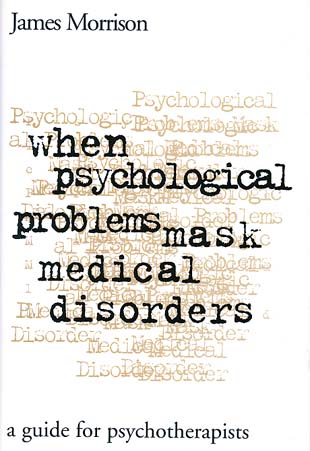When Psychological Problems
Mask Medical Disorders
Return to previous page
| Ok, the title is a mess, but I didn't choose it. The problem was to find
one that conveyed the purpose and sense of this volume. In that, at least,
it succeeds.
This book provides two services for therapists:
(1) In a walk through the mental status exam, it shows you the signs
and symptoms that may indicate medical illness. It discusses the need for
evaluation, how to make that evaluation, sources of error, and the parts
of the mental status exam: Appearance and Behavior, Mood (Affect), Speech,
Content of Thought, Intellectual Resources, and Insight and Judgment.
(2) The second part of this book presents 60 medical disorders that can
produce psychological symptoms. Each of these sections includes a brief
introduction, physical symptoms, mental symptoms, the best means for
evaluation, and the prognosis for the condition. A 20 page appendix
presents all the symptoms -- mental and physical -- in tabular form for
ready reference. I have also included some references for further reading
(and web browsing).
This book is available from Guilford
press or from Amazon.com. Below is
the entire text from a typical section. |
 |
Lyme Disease
| Occurrence |
Age of onset |
Gender |
Refer to |
| Frequent |
All ages |
About equal |
Internist |
| What: Infectious disease transmitted by bite of a
tiny tick |
| Physical: Headache, fever, chills, pains, fatigue,
malaise, stiff neck, paralysis, arthritis |
| Mental: Depression, psychosis, anxiety, mild
cognitive symptoms |
Lyme disease, properly known as Lyme borreliosis, is the most recently
identified disorder covered in this book. Yet, it is far from rare - over 1,000
cases per year are reported in this country alone, and it is also endemic
throughout much of Europe.
Named for the picturesque town in Connecticut where it was recognized in
1975, Lyme disease is caused by a microorganism belonging to the same family
that causes syphilis. This spirochete, Borrelia burgdorferi, is
transmitted by a tick so small that most people don't even remember being
bitten. The tick is carried by mice and deer, especially those indigenous to
Wisconsin, Minnesota, and the Northeast, from Maryland to Massachusetts. Hikers,
campers, and other outdoors people are especially at risk for contracting this
disease, which, not surprisingly, is most often reported during the summer
months.
B. burgdorferi is an equal-opportunity infectious agent, affecting all
ages and both sexes.
Physical Symptoms
Laboratory texts note that B. burgdorferi grows best on a complex
culture medium, but it thrives nicely in humans, too. The skin lesion begins as
a small, red dot that may be raised; it expands to form a larger, round lesion.
(Because it grows and moves, this pattern is called erythema migrans.) Several
days later the patient develops a flu-like illness, with headache, fever,
chills, and pains that seem to move from one muscle or joint to another. These
symptoms wax and wane in intensity, but the fatigue and sick feeling (malaise)
tend to persist.
Weeks to months later, about 15% of those who have not been adequately
treated will develop neurological symptoms such as paralysis of facial muscles,
meningitis (stiff neck), or encephalitis. A few patients develop heart block,
which is often asymptomatic but can cause palpitations, dizziness, and even loss
of consciousness. Still later, if still not treated, over half will develop the
painful, swollen joints of full-blown arthritis.
Mental Symptoms
Various reports suggest that anywhere from one-fourth to two-thirds of
patients will have symptoms of depression, which may not necessarily fulfill
criteria for a major depressive episode. Undoubtedly, the fatigue and difficulty
sleeping typical of Lyme disease contribute to the diagnosis of depression.
Many patients develop a mild encephalopathy - they show some difficulty
remembering things and some loss of mental flexibility. Psychotic symptoms
suggesting a schizophreniform or paranoid psychosis have also been reported.
Anxiety symptoms, including panic attacks and even obsessive-compulsive
behavior, have also been reported. Some patients have been noted to develop
symptoms of anorexia nervosa.
Evaluation
A serum antibody response develops to B. burgdorferi, but false
negatives are possible. Suspect Lyme disease in anyone with atypical mental symptoms, who lives in an area endemic for the disease or has
a history of tick bite or erythema migrans.
Outlook
Most patients recover completely with a course of oral antibiotics, which may
also eliminate psychotic and depressive symptoms. However, complete resolution
of all symptoms may take months or even longer, and several weeks of antibiotics
of treatment - or repeated courses of treatment - may be necessary. After months
or years untreated, the arthritis may become chronic. If the tick is removed
intact within 24 hours, infection by the spirochete may be prevented.
Return to Top